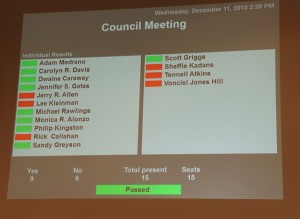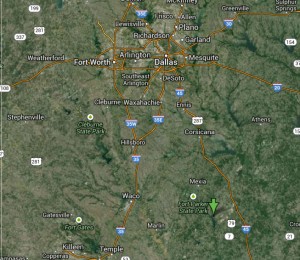Drilling in Dallas
New Encyclopedia of Fracking Harms
 Those that keep up with these things know the rate of new information about fracking has increased almost exponentially for the past couple of years. New studies arrive monthly covering a host of subjects – air pollution, water contamination, earthquakes from injection wells, truck traffic, etc. So many it's hard to keep up and get a view above the fray. Now, at least for the next couple of months, there's a new comprehensive guide for journalists, citizens, and policymakers that tries to put all the latest evidence into one publication.
Those that keep up with these things know the rate of new information about fracking has increased almost exponentially for the past couple of years. New studies arrive monthly covering a host of subjects – air pollution, water contamination, earthquakes from injection wells, truck traffic, etc. So many it's hard to keep up and get a view above the fray. Now, at least for the next couple of months, there's a new comprehensive guide for journalists, citizens, and policymakers that tries to put all the latest evidence into one publication.
Produced by the Concerned Health Professionals of New York, the new document has the slightly unwieldy title of "Compendium of Scientific, Medical, and Media Findings Demonstrating Risks and Harms of Fracking." Clocking in at over 60 pages, it does manage to cover a lot of ground, including air and water pollution, occupational hazards, noise pollution, earthquakes, flooding, radioactive releases, climate change, agricultural threats, crime rates, property values, and the inflated economics of gas reserves. In short, for now, it appears to be the one-stop shop for everything you wish you didn't need to know about fracking, but wanted to ask.
Extensively researched and footnoted, the Compendium is something you can hand your city council member or State Representative in hopes that their superficial scanning at least produces a better appreciation for the myriad of hazards now associated with the practice.
A Barnett Shale Manifesto…From Austin
 Sometimes it takes a perspective above the grind of trench warfare to give you a better sense of what the entire battlefield looks like. That's what UT Law Professor Rachel Rawlins has done for Barnett Shale activists with the recent publication of her article "Planning for Fracking on the Barnett Shale: Urban Air Pollution, Improving Health Based Regulation, and the Role of Local Governments" in the new Virginia Environmental Law Review.
Sometimes it takes a perspective above the grind of trench warfare to give you a better sense of what the entire battlefield looks like. That's what UT Law Professor Rachel Rawlins has done for Barnett Shale activists with the recent publication of her article "Planning for Fracking on the Barnett Shale: Urban Air Pollution, Improving Health Based Regulation, and the Role of Local Governments" in the new Virginia Environmental Law Review.
Don't let the academic title fool you. This is a call for a radically new approach to how communities in Texas regulate the risks of fracking, and every other type of heavy industry. We put the link up for the piece on our Facebook page on Saturday based on a quick reading of its commentary on the Flower Mound cancer cluster, but it's more, so much more than that. Among other things, it's a comprehensive rebuttal of every claim of safety and well-being ever issued by the industry or state authorities about the health of residents living in the Barnett Shale, of which the Flower Mound case is only one example. Rawlins has produced a one-stop catalog of each major air pollution health controversy in the Barnett since concerns began to grow in the last decade, with an almost 30-page review of why no industry or government-sponsored study of fracking pollution and its health effects is a satisfactory response to those concerns. Want to convince your local officials that fracking isn't as safe as it's touted? Here's the staggering blow-by-blow commentary to do it.
But all of that documentation is presented in service to making the point that current state and federal regulation of fracking is failing to protect public health, both in design and in practice. Professor Rawlins' solution to this problem is not to give the state and federal government more power to regulate the gas industry. No, it's to turn the current regulatory framework upside down and give more power to local governments to do the things that the state and federal government should be doing.
In making this recommendation, she echoes the strategy that's been driving Downwinders since it was founded – that the best way to regulate pollution problems is at the local level where the most harm is being done, and it should be directed by the people being harmed. This is what drove our Green Cement campaign that closed the last obsolete wet cement kiln in Texas. This is what fueled our campaign to close down the trailer park-come-lead smelter in Frisco. And it's what was behind the recent Dallas fights over drilling. In each case, it wasn't Austin or Washington DC that was the instrument of change – it was local governments, pressed by their constituents, flexing their regulatory powers. The same thing is driving activists in Denton who are organizing the ban fracking petition drive and vote.
This strategy avoids battles where industry is strongest – in the halls of the state capitol and in DC, where citizens are outspent millions to one. Instead, it takes the fight to neighborhoods where the harm is being done or proposed, where people have the most to lose, where the heat that can be applied to elected officials is more intense. Citizens will still get outspent, but the money doesn't seem to buy corporations as much influence among those actually breathing the fumes of the drilling site, or smokestack.
Particularly now, with corporate-friendly faux-Tea Party types in control of state government and the House of Representatives in DC, there is little room for grassroots campaigns to make a difference by passing new legislation. Even if by some miracle a few bills did pass, their enforcement would be up to the same state or federal agencies that are currently failing citizens. Local is more direct, and more accountable. Professor Rawlins agrees, and spends most of the rest of her 81-page journal article citing the ways in which local control of fracking in the Barnett Shale is hampered by the out-dated top-down approach to regulation, and what should be done to fix that.
Included in her recommendations are two long-term Downwinders projects: Allowing local governments to close the "off-sets" loophole for the gas industry that exempts them from having to compensate for their smog-forming pollution in already smoggy areas like DFW, and creating California-like local air pollution control districts that could set their own health based exposure standards and pollution control measures without having to go through Austin or DC.
If there's a single major fault in Rawlins's analysis, it's that she believes more local control of pollution risks is itself dependent on action by an unwilling state government. But Downwinders and others have shown that isn't true. Our most significant and far-reaching victories – from the closing of the Midlothian wet kilns to the new Dallas drilling ordinance – have all taken place while Rick Perry was Governor and the state legislature was in the hands of our opponents. We did these things despite Austin, not because we had its permission. Local zoning laws, local permitting rules, local nuisance acts, and other local powers are under-utilized by both residents and their elected officials when it comes to pollution hazards.
The same is true now of Downwinders' off-sets campaign aimed at the gas industry. We think we've found a way to avoid the "preemption" argument that would keep local governments from acting on smog pollution from gas sources by aiming the off-sets at Greenhouse gases – an area of regulation Texas is loathe to enter. By targeting GHG reduction, we also reduce a lot of toxic and smog-forming air pollution. It's a back door way, but it accomplishes the same goal. It's going to be up to Texas activists to sew similar small threads of change through an otherwise hostile political environment.
Even given that flaw, Professor Rawlins' introduction to her article is the most concise summary of the air pollution problems caused by gas mining and production in the Barnett, as well as the most credible call to action for a new way of doing business there. Here it is reprinted in full for your consideration:
In the last decade hydraulic fracturing for natural gas has exploded on the Barnett Shale in Texas. The region is now home to the most intensive hydraulic fracking and gas production activities ever undertaken in densely urbanized areas. Faced with minimal state and federal regulation, Texas cities are on the front line in the effort to figure out how best to balance industry, land use, and environmental concerns. Local governments in Texas, however, do not currently have the regulatory authority, capacity, or the information required to closet he regulatory gap. Using the community experience on the Barnett Shale as a case study, this article focuses on the legal and regulatory framework governing air emissions and proposes changes to the current regulatory structure.
Under both the state and federal programs, the regulation of hazardous air emissions from gas operations is based largely on questions of cost and available technology. There is no comprehensive cumulative risk assessment to consider the potential impact to public health in urban areas. Drilling operations are being conducted in residential areas. Residents living in close proximity to gas operations on the Barnett Shale have voiced serious concerns for their health, which have yet to be comprehensively evaluated. Given the complexityof the science, and the dearth of clear, transparent, and enforceable standards, inadequate studies and limited statistical analysis have been allowed to provide potentially false assurances. The politically expedient bottom line dominates with little attention paid to the quality of the science or the adequacy of the standards.
Determining and applying comprehensive health-based standards for hazardous air pollutants has been largely abandoned at the federal level given uncertainties in the science, difficulties of determining and
measuring “safe” levels of toxic pollutants, and the potential for economic disruption. Neither the state nor the federal government has set enforceable ambient standards for hazardous air pollutants.Identifying cumulative air pollution problems that may occur in urban areas, the State of California has called upon local governments to identify “hot spots” and to consider air quality issues in their planning and zoning actions. In Texas, however, preemption discussions dominate the analysis. Any local government regulation that might provide protection from toxic air emissions otherwise regulated by the State must be justified by some other public purpose.
Texas should consider authorizing and encouraging local level air quality planning for industrial activities, similar to what California has done. Care should be taken to separate these facilities from sensitive receptors and “hot spots” that may already be burdened with excessive hazardous air emissions. Given the difficulty of the task, there is also an important role for the state and federal governments in working to establish ambient standards for hazardous air pollutants, as well as standards for health based assessment and public communication. The uncertainty inherent in any of these standards should be made clear and accessible to local governments so that it may be considered in making appropriate and protective land use decisions. Texas should consider allowing local governments to have the power to establish ambient air quality standards, emissions limitations, monitoring, reporting, and offsets for hazardous air pollutants, following the model applied to conventional air pollutants pursuant to the federal program.
Professor Rawlins' article provides Barnett Shale activists with a new map to guide them toward more effective action. We'd all do well to study it and pick local battles that promise to contribute toward its realization.
Can a Council Whose Majority Voted for the Trinity East Permits Now be Expected to Defend the City’s Denial?
 As you might have heard by now, forlorn natural gas operator Trinity East has sued the City of Dallas for denying the three permits it was seeking to drill along the Trinity River in Northwest Dallas by the Irving border. Claiming breach of contract and even fraud, the company is saying it's owed millions of dollars above and beyond the $19 million it spent on leases for the three sites.
As you might have heard by now, forlorn natural gas operator Trinity East has sued the City of Dallas for denying the three permits it was seeking to drill along the Trinity River in Northwest Dallas by the Irving border. Claiming breach of contract and even fraud, the company is saying it's owed millions of dollars above and beyond the $19 million it spent on leases for the three sites.
Anyone who's seen the filing knows this is a lawsuit with no legs. Yes, Trinity East leased the land, but guarantees about permits being awarded were not part of the deal. Those can't be bought so blatantly. Even Mary Suhm's secret memo un-earthed last February by the Dallas Observer made it clear that her assistance was not a guarantee and "not a legally binding agreement." The leases were one thing. The permits another. Trinity East thought it had the permits in hand when Suhm signed her memo. So did Suhm.
That's why citizens were told in 2012 that Trinity East permits were a "done deal" by sources in City Hall, including Mayor Rawlings, who seems to have known about the Suhm memo before the public did. There was just no way those permits were going to be denied. Suhm and the Mayor were not going to let that happen. That's why they called for the hearing and permit vote two days before Christmas. They thought no one would show and they could wrap it up. So it was a big surprise when the City Plan Commission voted to deny the TE permits. Undeterred, there was suddenly a call for an unprecedented, second "reconsideration vote" by the Plan Commission by the Mayor's representative on the same permits. But Trinity East lost that fight too, by a wider margin, in January of 2013. This time without any public hearing.
When the CPC denial came to the City Council in August of 2013, charter rules demanded it must be overridden by a super majority of 12. The vote to overturn the CPC's denial was 9 to 6, leaving the denial in place, but showing a majority of the current council in favor of granting the permits.
Then the strategy turned to adapting the new drilling ordinance to fit the Trinity East permits. If they couldn't make it through the front door, they could go in the back way. And so City legal staff tried to manipulate the City Plan Commission into carving out exceptions in the new draft ordinance that would allow that. Instead of a 1500-foot setback, they urged 1000 feet with a variance back to 500 feet. That would allow all Trinity East sites. Then they tried to ease the rules on park drilling, and even succeeded to some extent, softening a ban on surface drilling in parks that was part of the old ordinance.
Only Dallas residents working overtime and applying more scrutiny saved the day and got Plan Commission support for a new ordinance that did finally shut the door on all three Trinity East permits. And of course, that's when Trinity East, aided by the entire gas industry, decided to sue.
So you now have the weird situation where the same City Hall that was trying so desperately to win those permits for Trinity East is now being sued by the company for not being conspiratorial enough to subvert the public process. Yesterday, the city issued an statement saying the company's lawsuit lacked merit and, "The city will vigorously defend its right to exercise its regulatory powers to protect public health and safety as well as the environment."
But here's the thing. Since a clear majority of current Dallas City Council members voted for the permits, how much will power is there among this same group to now defend a position they didn't take? And since it was often the Dallas City Attorney's office leading the charge to manipulate the system on Trinity East's behalf, how well do you trust that same crew to "vigorously defend" the outcome they tried so hard to prevent?
Three are some legal principles involving the city's right to control its own zoning decisions which could motivate the city and/or the Texas Municipal League into such a defense. But you have to wonder how much heart they really have for a fight, of which right up until the last vote, they were on the same side as the company now suing them.
To make sure the City doesn't settle with Trinity East, citizens are going to have to persuade the three council members who voted with them for the new ordinance, but against them on the Trinity East permits to change their minds – Jennifer Staubach-Gates, Dwaine Carrawy and Mayor Ralwings.
That won't be easy. Rawlings was making the "I told you so" rounds in the media yesterday. The first sign that they might be serious about defending themselves is whether they'll hire an outside law firm with municipal law experience to represent them. If they put the same people in the City Attorney's office who were working in concert with Trinity to win those permits in charge of this fight, we're doomed. If they hire a competent firm with a reputation for toughness, you'll know they think there might be some points of law worth going to court for.
Longer term, it once again puts a spotlight n the need to elect additional allies of the six council members who've been reliable allies to citizens on this issue. This coming Dallas municipal election cycle in 2015 will see almost half the council seats up for grabs as incumbents are term-limited out. Stay tuned.
Merry Xmas and Have a Less Poisonous New Year
Dallas Council Passes 1500 Foot Setback and Rest of Draft Ordinance
 It was rumored to be a done deal as of last week. Today it actually is.
It was rumored to be a done deal as of last week. Today it actually is.
By a vote of 9 to 6, the Dallas City Council voted to endorse the new gas ordinance drafted by its City Plan Commission, including its 1500-foot setback requirement for wells and compressor stations.
The only change to the Commission recommendations came in a procedural tweak that now requires six votes to stop a variance being rolled back to a minimum of 1000 feet instead of four.
Oak Cliff Council Member Scott Griggs made the motion to approve the Plan Commission recommendations. Before his motion could be voted on however, East Dallas Council Member Sheffie Kadane made a substitute motion to reduce the required setback to 500 feet. This was the stark choice that faced the Council.
They chose wisely. 1500 feet matches the most protective buffer zone current restrictions in the Barnett Shale. It's more than twice as far as the 600 foot setback on the books in Fort Worth. Even the new Dallas minimum of 1000 feet is 400 more than Forth Worth's maximum. Much of todays' public hearing testimony touched on health effects felt by Shale residents who had lived from 300 to 1200 feet from wells.
Along with the defeat of the Trinity East permits earlier in the year, passage of the Dallas ordinance represents the biggest recent victories of urban fracking opponents in the Barnett Shale.
Not only is there a brand new "Dallas Model" to compete and contrast with the "Fort Worth Model" that industry loves to tout, but there's a brand new feeling that environmentalists actually have some clout in city politics in Dallas for the first time.
Congratulations to all those who worked so hard to see this result happen against so many obstacles over the last four years. Well done.
Beginning at 1pm Today, Walk the Last 1500 Feet With Us
 It's been four years since the first Dallas City Plan Commission meetings on pending gas permits. It's been three years since the Dallas Gas Drilling Task Force was formed. It's been 12 months since Mayor Rawlings' announced he was fast tracking the Trinity East gas permits. It's been 10 months since the Dallas Observer published former City Manager's embarrassing secret deal over park land drilling between herself and Trinity East. It's been seven months since Suhm announced her retirement. It's been four months since the Trinity East permits went down in defeat. It's been three months since the Plan Commission passed its draft of the new Dallas Gas Ordinance, including a provision for a 1500-foot setback. What a long, strange trip.
It's been four years since the first Dallas City Plan Commission meetings on pending gas permits. It's been three years since the Dallas Gas Drilling Task Force was formed. It's been 12 months since Mayor Rawlings' announced he was fast tracking the Trinity East gas permits. It's been 10 months since the Dallas Observer published former City Manager's embarrassing secret deal over park land drilling between herself and Trinity East. It's been seven months since Suhm announced her retirement. It's been four months since the Trinity East permits went down in defeat. It's been three months since the Plan Commission passed its draft of the new Dallas Gas Ordinance, including a provision for a 1500-foot setback. What a long, strange trip.
Today, we're down to the final public hearing and the final council vote on that new ordinance. The only mystery left is whether that 1500-foot setback will remain in place or be whittled back to allow drilling as close as 500 feet to homes. It's the difference between matching the most protective buffer zone in the region, or following the lead of the most permissive cities in the Shale like Fort Worth.
We're poised to win one of the biggest victories against the gas lobby in North Texas since urban drilling began in 2006. We're on the verge of creating a new model for cities, one that better incorporates the newest science and technology. All it takes is one more push, one more vote.
Many of you have been with us every step since 2011. Many others have fallen in along the way. We're asking all of you to walk that final 1500 feet with us today. Come down to City Hall at 1 and participate in the news conference in the Flag Room on the 6th floor just outside the Council Chambers. Speak for the allotted three minutes at the public hearing on the gas ordinance that will follow, witness history, and then come to what we hope will be a victory celebration at Lee Harvey's afterwards.
Don't let the last four years be in vain. Come on down to City Hall and help us finish the job. Thanks.
Don’t Miss the Big D Finale to the Dallas Gas Wars On Wednesday
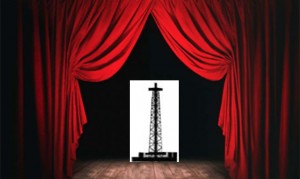 It All Comes Down To This Last Public Hearing and Final Vote on a New Drilling Ordinance
It All Comes Down To This Last Public Hearing and Final Vote on a New Drilling Ordinance
Beginning 1:00 PM
THIS WEDNESDAY, DECEMBER 11th
6th Floor Dallas City Hall
Participate, and (with any luck) Celebrate…..Over a Year of Constant Activism…….Over Three Years of Constant Organizing…….The Defeat of the Trinity East Permits………The Passage of Protective Dallas Gas Ordinance
After the Vote at City Hall. Come Raise a Glass with us at Lee Harvey's Bar, at 1807 Gould St.
THIS WEDNESDAY'S SCHEDULE
1:00 pm
Citizens' Press Conference
with special guests
1:30 pm
Final City Council Public Hearing on Gas-Drilling
ordinance
Following the Public Hearing, the City Council will have its final vote on the ordinance
Following the Council's vote, we'll reconvene at Lee Harvey's, the official bar of the Dallas Gas Wars.
Even if you Don't Live in Dallas, You Can Help Us Bring the REAL Barnett Shale to the Public Hearing on Wednesday
One of the constant refrains of our opponents on the Council is that drilling has been "going on for years in the Barnett Shale with no apparent harm." In particular, they love to use Fort Worth as a model for how Dallas should regulate gas drilling.
We know many of you have a different story to tell because you've experienced drilling up close and personal, or have family or friends who have.
The Dallas Residents at Risk alliance has put out a call for Wednesday's public hearing on the new gas ordinance that will proceed the final vote.
We're asking residents of the Barnett Shale who've been harmed by drilling to submit their testimony to the Dallas City Council.
You can do this directly by coming to the hearing Wednesday afternoon and testifying yourself, or you can submit you testimony to us at info@downwindersatrisk.org and we'll ask a Dallas resident to read it into the record for you.
We'll have these first-hand statements available for Dallas residents who want to help read them into the record at the 1pm press conference preceding the public hearing.
Our goal is to paint a more realistic picture of what it's like to live with gas drilling and production on a daily basis before the final vote on a new Dallas gas ordinance is taken. Please help us paint that picture.
How The Vote Looks as of Monday
Whatever happens on Wednesday, it'll be a close vote. There are still six votes against the new ordinance, and six votes for it. Mayor Rawlings, and Council members Jennifer Staubach-Gates and Dwaine Caraway are all officially undecided and hold the key to victory for either side. We must have at least 8 out of the 15 members vote with us to win.
Thanks to you, each of these three officially-undecided council members has received hundreds of e-mails supporting the new ordinance and its 1500-foot setback over the past week or so. We understand that they may be having an impact, along with phone calls, visits, and everything else residents are doing to try and persuade these three Council members to do the right thing. (If you still want to reach them here's their contact info.)
Thank you for doing all that you've done. We couldn't have gotten as far as we have without our army of citizen-lobbyists. But now we need your butt in a seat one last time at City Hall on Wednesday to close the deal. Please come if you can. Thanks.
D-Day Minus 7: Dallas Gas Ordinance Countdown
Considering how little public notice there was, yesterday's Dallas City Council "public comment time" on the new gas-drilling ordinance was well-attended by residents supporting the Plan Commission Draft. Over two dozen people spoke in favor of the CPC recommendations, including the 1500 foot setback, and/or stronger language for parks and flood plains. Murky statements by the Mayor about whether speaking this week would disqualify you from also having your say at next week's public hearing immediately prior to the final Council vote kept other residents from going to the podium.
True to whatever consultant's media training rule book they're following, industry representatives waited until they thought citizen testimony ended to make their condescending case that citizens were relying only on fear and didn't really understand the fracking process. The problem with this strategy is that you have to pretend the previous 45 minutes of citizen testimony never happened, since it's always replete with references to new scientific studies showing increased health harms from fracking, or another connection with earthquakes, or just strange foamy crap falling out of the sky into your yard from the rig down the street. It turns out the industry folks are the ones who don't really know the process.
And as fate would have it, citizens weren't through testifying. Right after telling the City Council how much West Dallas would lose out by not embracing fracking in its neighborhoods, up popped a West Dallas resident who said she wanted nothing to do with the industry, no matter how much money was involved. After another industry spokesman again said supporters of a stronger ordinance were just imagining harms they weren't really there, Sierra Club member Molly Rooke gave a devastatingly effective presentation on exactly how real harms to real people had forced her own group to acknowledge the dangers of gas pollution after initially endorsing natural gas as an entirely green fuel.
Unlike the staff briefing of two weeks ago, which allowed industry supporters on the Council to bloviate at will over what a crime it was to limit drilling in Big D, nobody behind the horseshoe did any talking except the Mayor, who was perfunctory in his opening and closing remarks and didn't give any clues as to his position on the CPC draft. According to Rawlings, it was his idea to have this "public comment time" prior to the final hearing so there wouldn't be the pile-up there was during the Trinity East vote, where you felt more like you were a cog in an assembly line instead of a citizen participating in one the small pageants of American democracy.
At the end of the meeting, Texas Campaign for the Environment members unfurled a banner urging Rawlings to "Be Strong," which was quickly confiscated by the City Hall Police Rapid Protest Response Team. Here's the Dallas Morning News' muted coverage of the event.
Because of the weather, Dallas Residents at Risk is waiting until next Monday to gin up a final push for passage of the Plan Commission draft going into Wednesday's final public hearing and vote beginning at 1 pm at City Hall. Please stay tuned for details about how you can express your public support and send a message to the Council to pass a strong ordinance. We know we sound like a broken record, but if you haven't sent a quick e-mail to the Mayor yet, you can click here and do so within a minute pretty painlessly. If you want a short explanation of what's going and what votes are where, you can read this previous post and get caught-up.
We have only a week to make sure our last year's worth of hard uphill slogging through corruption, double-dealing, and aggressively ignorant bureaucracies is not in vain. Please help us make it the last 1500 feet.
D Day (Drilling Day) Minus 8: Latest on Dallas Gas Ordinance
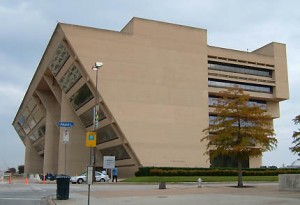 If you can, please be sure and attend and speak-up during the public comment time being offered by the Dallas City Council today at 1 pm. Although hastily-called on the day before Thanksgiving, this "unofficial" hearing is a chance for you to speak to Council Members while things still seem to be in motion at City Hall, as opposed to next Wednesday's official hearing and vote, when things might have already been settled.
If you can, please be sure and attend and speak-up during the public comment time being offered by the Dallas City Council today at 1 pm. Although hastily-called on the day before Thanksgiving, this "unofficial" hearing is a chance for you to speak to Council Members while things still seem to be in motion at City Hall, as opposed to next Wednesday's official hearing and vote, when things might have already been settled.
In other ordinance-related news……
– The Dallas Morning News published an excellent editorial in today's edition (reprinted below) urging the council to approve the City Plan Commission draft ordinance as is. "Council members should remember that their first obligation is to protect existing neighborhoods. This proposal is reasonable and offers far better protections for residents than had existed on the books. The council should adopt it."
– According to more than one source at City Hall, Dallas "Sustainability Department" staffer David Cossum, and our old friend City Attorney Tammie Palomino were going door-to-door through the council members offices trying to drum up support for a 1500 foot maximum buffer zone that then could be reduced to as little as 500 feet with a "variance." This is an option that has never been on the table before – it was never discussed by the Plan Commission, who wanted a 1000 foot minimum. You'll recall these are the same City Hall staffers who lead the Gas Drilling Task Force down the garden path to carve out exemptions for the Trinity East permits without public knowledge. They are the same staffers who tried more than once to get the Plan Commission to back down from their support of a 1500 foot setback. According to our sources, the pair failed in getting the majority support they needed to go forward with their scheme. If you think ex-but-still-hanging-around former City Manager Mary Suhm isn't still having an impact at 1500 Marilla, this news should set you straight.
– There's a rumor of a deal between Council factions that would preserve the 1500 foot setback but allow variances down to 1000 feet on a 2/3rds vote, instead of the super majority 3/4's proposed by the City Plan Commission. In other words, a motion to reduce the setback or buffer zone from 1500 to 1000 feet for any well would require at least 6 votes to block under the 2/3rds provision vs. just four members having veto power under a 3/4's rule. We haven't heard a single argument to explain why this tweak is necessary or desirable. It could be petty politics – Rawlings doesn't want Griggs and Company having full veto power. Or it could be something more strategic that has to do with a specific site or operator, the way the City tried to shape the Task Force recommendations for the Trinity East permits without the public knowing what was going on.
If you haven't sent an e-mail to Mayor Rawlings requesting that he vote for the Plan Commission draft and its 1500 foot setback, please click here now and do so. And here's yesterday's post explaining the situation, and offering the e-mail addresses and phone numbers of Mayor Rawlings, Jennifer Staubach-Gates and Dwaine Caraway in case you want to contact the only three uncommitted council members left.
You only have until next Wednesday to influence these votes on the Council. Then it's all over, so please, do it now. Thanks.
Editorial: Dallas must not weaken balanced gas drilling rules
After nearly two years of contentious political haggling, the Dallas City Council will hear public comments Wednesday on proposed tougher gas drilling rules, the final step before the council votes on the plan next Wednesday. This newspaper urges council members to resist pressure to water down the City Plan Commission’s strong measure and adopt those recommendations in their entirety.
The Plan Commission has done a lot of hard work, resulting in new rules that fairly balance the rights of drillers against protections for Dallas neighborhoods from downsides of urban drilling.
For example, the commission is urging the council to enact a minimum 1,500-foot buffer zone around drilling sites, with a provision allowing a reduced 1,000-foot buffer zone in certain circumstances. That was a wise, hard-fought compromise intended to assure neighborhoods are free from excessive noise and possible health threats, and it is in line with setbacks enacted in other North Texas cities, such as Flower Mound.
It is also a major improvement over Dallas’ current rule, which permits drilling within 300 feet of schools, churches and residential areas. Although some council members say the 1,500-foot setback might draw a lawsuit from drillers, the greater distance setback is in the best interests of Dallas residents.
Other key provisions would require drillers to disclose all hazardous materials used on a drilling site, restrict drilling during droughts, and ban wastewater injection wells, which some experts suspect are tied to earthquake activity. We’re also impressed that plan commissioners are urging the council to consider establishing a pollution-offsets program to make sure drilling won’t undermine the region’s overall efforts to clean the air. These all are reasonable and extremely important safeguards that need to be in place before urban drilling is allowed.
Unfortunately, the commission didn’t recommend an outright ban on drilling in floodplains and on parkland, but at least the panel has recommended that the council set a reasonably high bar — a three-quarters vote — before drilling would be permitted in parks.
Overall, this is a good ordinance because it doesn’t give drillers carte blanche yet recognizes that urban gas drilling is part of America’s energy future. Nor does the proposal let the perfect be the enemy of the good. Thus the council should not undo the constructive work of plan commissioners with last-minute changes that would weaken the ordinance.
Council members should remember that their first obligation is to protect existing neighborhoods. This proposal is reasonable and offers far better protections for residents than had existed on the books. The council should adopt it.
KEY VICTORIES
• Setbacks of drilling operations from schools, churches and homes to a minimum 1,500-foot buffer zone around all sites. Drillers could request a 1,000-foot zone in certain circumstances.
• Authority for the city to impose water restrictions during drought conditions.
• Requirement for drillers to disclose all hazardous materials used on a site.
• Ban on wastewater injection wells from being drilled within city limits.
• Proposed pollution-offsets program to protect air quality.
The New Gas Pollution Problem for DFW in Two Pictures
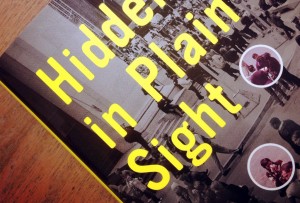 So far the debate over how much impact the gas industry has had on DFW air quality has centered on the Barnett Shale. That's logical because that's the gas play right in front of us, in the middle of the North Texas "non-attainment area" for smog. One of the main arguments Rick Perry's Texas Commission on Environmental Quality has made against any significant impact is that most of the drilling is happening west of the DFW urban centers.
So far the debate over how much impact the gas industry has had on DFW air quality has centered on the Barnett Shale. That's logical because that's the gas play right in front of us, in the middle of the North Texas "non-attainment area" for smog. One of the main arguments Rick Perry's Texas Commission on Environmental Quality has made against any significant impact is that most of the drilling is happening west of the DFW urban centers.
Ignoring how geographically-incorrect this argument is – there's drilling and compressors in Dallas County right now, much less Ellis, Johnson. Denton and Tarrant – let's just cede the argument to the state that it would take gas fields to the Southeast of us, that is, upwind of us during ozone season, to really impact our air quality.
Guess what? There's gas fields Southeast of DFW that are producing lots of air pollution.
In previous posts over at least the last two years, we've shown that if you add up the standard permits of all the gas compressors in Freestone County alone, they represent more smog pollution than the Big Brown Coal Plant doing business down the road. Now there's new evidence of the size of these gas fields and their relationship to the DFW airshed, thanks to Google.
Here's a picture of the area we're talking about – just about an hour and a half drive southeast of DFW, east of Waco. That makes it directly upwind during ozone seasons.
When you zoom into where the green arrow is, you see the familiar sight of hundreds of square drilling pads laid out over the landscape – just like the Barnett Shale – only DFW is directly downwind of it during the summer.
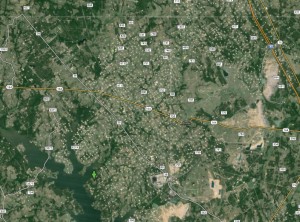 Pollution from these sources has most likely been grossly underestimated by the state. Moreover, when gas field pollution comes into an urban area with dirty air, it increases the likelihood of that pollution turning into smog. Rick Perry's employees are loath to admit the gas industry plays any part in the stagnation of DFW air quality progress since 2007, but as these images make clear, facts on the ground trump their ideology.
Pollution from these sources has most likely been grossly underestimated by the state. Moreover, when gas field pollution comes into an urban area with dirty air, it increases the likelihood of that pollution turning into smog. Rick Perry's employees are loath to admit the gas industry plays any part in the stagnation of DFW air quality progress since 2007, but as these images make clear, facts on the ground trump their ideology.

